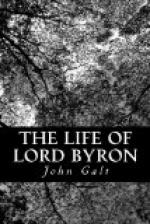CHAPTER XXIII
Constantinople—Description—The Dogs and the Dead—Landed at Tophana—The Masterless Dogs—The Slave Market—The Seraglio—The Defects in the Description
The spot where the frigate came to anchor affords but an imperfect view of the Ottoman capital. A few tall white minarets, and the domes of the great mosques only are in sight, interspersed with trees and mean masses of domestic buildings. In the distance, inland on the left, the redoubted Castle of the Seven Towers is seen rising above the gloomy walls; and, unlike every other European city, a profound silence prevails over all. This remarkable characteristic of Constantinople is owing to the very few wheel-carriages employed in the city. In other respects the view around is lively, and in fine weather quickened with innumerable objects in motion. In the calmest days the rippling in the flow of the Bosphorus is like the running of a river. In the fifth canto of Don Juan, Lord Byron has seized the principal features, and delineated them with sparkling effect.
The European with the Asian shore,
Sprinkled with palaces, the ocean
stream
Here and there studded with a seventy-four,
Sophia’s cupola with golden
gleam;
The cypress groves; Olympus high
and hoar;
The twelve isles, and the more than
I could dream,
Far less describe, present the very view
Which charm’d the charming Mary Montague.
In the morning, when his Lordship left the ship, the wind blew strongly from the north-east, and the rushing current of the Bosphorus dashed with great violence against the rocky projections of the shore, as the captain’s boat was rowed against the stream.
The wind swept down the Euxine, and the wave
Broke foaming o’er the blue Symplegades.
’Tis a grand sight, from off the giant’s
grave,
To watch the progress of those rolling seas
Between the Bosphorus, as they lash and lave
Europe and Asia, you being quite at ease.
“The sensations produced by the state of the weather, and leaving a comfortable cabin, were,” says Mr Hobhouse, “in unison with the impressions which we felt, when, passing under the palace of the sultans, and gazing at the gloomy cypresses, which rise above the walls, we saw two dogs gnawing a dead body.” The description in The Siege of Corinth of the dogs devouring the dead, owes its origin to this incident of the dogs and the body under the walls of the seraglio.
And he saw the lean dogs beneath the wall,
Hold o’er the dead their carnival.
Gorging and growling o’er carcase and limb,
They were too busy to bark at him.
From a Tartar’s scull they had stripp’d
the flesh,
As ye peel the fig when its fruit is fresh,
And their white tusks crunched on the whiter scull,
As it slipp’d through their jaws when their
edge grew dull.
As they lazily mumbled the bones of the dead,




